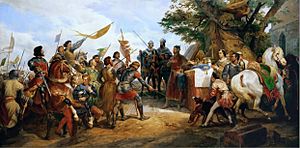Anglo-French War (1213–1214) facts for kids
Quick facts for kids Anglo-French War |
|||||||
|---|---|---|---|---|---|---|---|
| Part of the Capetian–Plantagenet rivalry | |||||||
 Philip II of France at the Battle of Bouvines |
|||||||
|
|||||||
| Belligerents | |||||||
|
|||||||
| Commanders and leaders | |||||||
|
|||||||
The Anglo-French War was a big fight in the Middle Ages. It happened between the Kingdom of France and the Kingdom of England. Other countries also joined in.
King John of England wanted to get back lands in France. He had lost these lands to King Philip II of France about ten years earlier. Philip was becoming very powerful. This war was the first time many countries teamed up against France. It ended with the important Battle of Bouvines, where Philip defeated England and its allies.
Why the War Started
The Duchy of Normandy was a key area. It was very close to Paris, France's capital. English kings had to protect their lands there. In 1202, King Philip II of France invaded Normandy. He took over the duchy and nearby areas. This included a long siege of a strong castle.
King John of England wanted his lands back. In 1214, Pope Innocent III helped create an alliance against France. King John joined this group.
The Battle of Bouvines
The allied armies met King Philip near a place called Bouvines. Philip's French army won a great victory. This defeat meant King John could not get his lost lands back. France also gained control of Flanders.
This war was part of a much longer struggle. It was between two powerful families: the House of Capet (from France) and the House of Plantagenet (from England). This rivalry lasted for about a century. It began when Henry II of England became king in 1154. It ended with Louis IX of France winning against Henry III of England in 1242.
What Happened After the War
After losing the war and many lands in France, King John became very unpopular. A civil war started in England. Many English lords rebelled against him.
Some of these rebellious lords asked Prince Louis for help. Louis was King Philip's son. He was also King Henry II of England's grandson-in-law. Even though his father and the Pope told him not to, Louis sailed to England. He arrived with an army in June 1216. Louis captured Winchester and soon controlled more than half of England.
But then, King John suddenly died in October. The rebellious English lords changed their minds. They left Louis and supported John's nine-year-old son, Henry III.
William Marshall became the regent for young King Henry. He encouraged the English to fight the French. The tide turned on the battlefield. Louis's army was defeated at Lincoln in May 1217. A French fleet bringing help was also beaten off the coast of Sandwich in August.
Louis had to agree to peace terms with England. The Treaty of Lambeth was signed. It said that English rebels would be forgiven. Louis promised not to attack England again. He also received 10,000 marks. The treaty meant Louis agreed he was never the rightful King of England.

